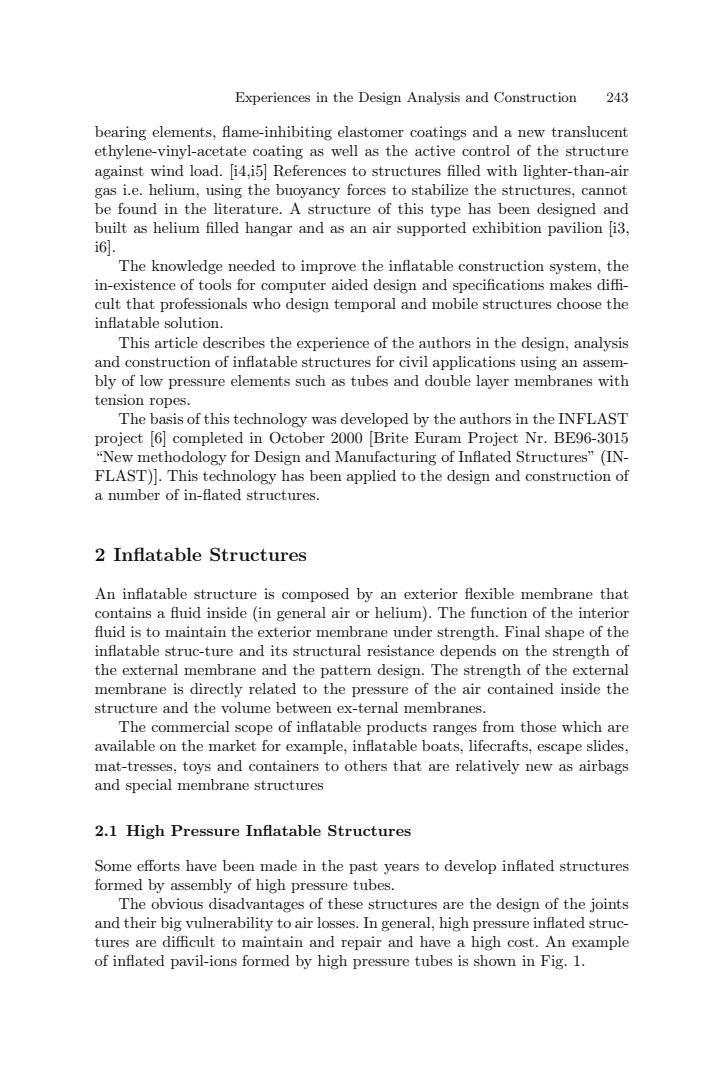正在加载图片...

Experiences in the Design Analysis and Construction 243 bearing elements,fame-inhibiting elastomer coatings and a new translucent ethylene-vinyl-acetate coating as well as the active control of the structure against wind load.i4,i5]References to structures filled with lighter-than-air gas i.e.helium,using the buoyancy forces to stabilize the structures,cannot be found in the literature.A structure of this type has been designed and built as helium filled hangar and as an air supported exhibition pavilion i3, i6. The knowledge needed to improve the inflatable construction system,the in-existence of tools for computer aided design and specifications makes diffi- cult that professionals who design temporal and mobile structures choose the inflatable solution. This article describes the experience of the authors in the design,analysis and construction of inflatable structures for civil applications using an assem- bly of low pressure elements such as tubes and double layer membranes with tension ropes. The basis of this technology was developed by the authors in the INFLAST project [6]completed in October 2000 Brite Euram Project Nr.BE96-3015 "New methodology for Design and Manufacturing of Inflated Structures"(IN- FLAST)].This technology has been applied to the design and construction of a number of in-flated structures. 2 Inflatable Structures An inflatable structure is composed by an exterior flexible membrane that contains a fluid inside (in general air or helium).The function of the interior fluid is to maintain the exterior membrane under strength.Final shape of the inflatable struc-ture and its structural resistance depends on the strength of the external membrane and the pattern design.The strength of the external membrane is directly related to the pressure of the air contained inside the structure and the volume between ex-ternal membranes. The commercial scope of inflatable products ranges from those which are available on the market for example,inflatable boats,lifecrafts,escape slides, mat-tresses,toys and containers to others that are relatively new as airbags and special membrane structures 2.1 High Pressure Inflatable Structures Some efforts have been made in the past years to develop inflated structures formed by assembly of high pressure tubes. The obvious disadvantages of these structures are the design of the joints and their big vulnerability to air losses.In general,high pressure inflated struc- tures are difficult to maintain and repair and have a high cost.An example of inflated pavil-ions formed by high pressure tubes is shown in Fig.1.Experiences in the Design Analysis and Construction 243 bearing elements, flame-inhibiting elastomer coatings and a new translucent ethylene-vinyl-acetate coating as well as the active control of the structure against wind load. [i4,i5] References to structures filled with lighter-than-air gas i.e. helium, using the buoyancy forces to stabilize the structures, cannot be found in the literature. A structure of this type has been designed and built as helium filled hangar and as an air supported exhibition pavilion [i3, i6]. The knowledge needed to improve the inflatable construction system, the in-existence of tools for computer aided design and specifications makes diffi- cult that professionals who design temporal and mobile structures choose the inflatable solution. This article describes the experience of the authors in the design, analysis and construction of inflatable structures for civil applications using an assembly of low pressure elements such as tubes and double layer membranes with tension ropes. The basis of this technology was developed by the authors in the INFLAST project [6] completed in October 2000 [Brite Euram Project Nr. BE96-3015 “New methodology for Design and Manufacturing of Inflated Structures” (INFLAST)]. This technology has been applied to the design and construction of a number of in-flated structures. 2 Inflatable Structures An inflatable structure is composed by an exterior flexible membrane that contains a fluid inside (in general air or helium). The function of the interior fluid is to maintain the exterior membrane under strength. Final shape of the inflatable struc-ture and its structural resistance depends on the strength of the external membrane and the pattern design. The strength of the external membrane is directly related to the pressure of the air contained inside the structure and the volume between ex-ternal membranes. The commercial scope of inflatable products ranges from those which are available on the market for example, inflatable boats, lifecrafts, escape slides, mat-tresses, toys and containers to others that are relatively new as airbags and special membrane structures 2.1 High Pressure Inflatable Structures Some efforts have been made in the past years to develop inflated structures formed by assembly of high pressure tubes. The obvious disadvantages of these structures are the design of the joints and their big vulnerability to air losses. In general, high pressure inflated structures are difficult to maintain and repair and have a high cost. An example of inflated pavil-ions formed by high pressure tubes is shown in Fig. 1